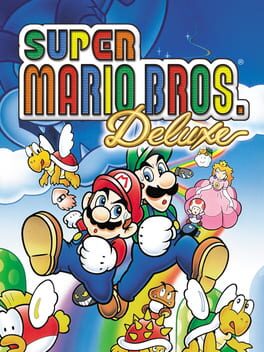It’s frustrating but also kind of fascinating to see how one simple technical limitation can outweigh all the expanded content this port has going for it. Most of the aesthetic and gameplay additions are good and should easily make this the best version to experience the first Super Mario Bros. – except that screen crunch is real and truly crushing in this case. The degree to which the perspective was zoomed-in seems almost absurd in direct comparison to the NES original. Nothing more than a fraction of the screen remains in the frame, even the clouds in the sky had to be pulled down to keep them visible at all. The game somewhat tries to mitigate this drastically reduced field of vision by making some tweaks to the camera placement. For example, Mario is positioned to the left of the screen instead of in the middle. While certainly a necessary adjustment, this doesn't change that you still can see significantly less of what lies ahead of you than on the NES. You are also now able to slightly move the camera to the left when turning backwards, but only as far as the screen size from the original would have allowed for, which feels weirdly unintuitive. The rules of the NES code still apply, only that you are unable to see them now.
But the most awkward addition must be the new option to scroll the screen up and down. Not only does the ability to move the camera independently from the character completely interrupt the flow of movement in a 2D platformer like Super Mario where perception and mobility are so tightly interwoven. It also is poorly implemented, again stemming from the root cause of screen crunch. Because the frame is so tiny to begin with, every camera movement feels too fast and abrupt. At the same time, the range of possible camera movement is also too small because the camera remains tied to Mario, who has to stay visible at all times.
Consequently, the level design loses one of its most defining features: verticality. Gone is the active decision-making of choosing between multiple paths, since the consequences of each option are barely foreseeable. If anything, this illustrates just how perfectly placed the camera was on the NES. A big reason why the platforming in Super Mario Bros. feels so satisfying is because of how intentionally you are able to execute your movement. You always know where Mario is going to land when you press the jump button, but every forward movement still reveals enough of the stage to force you to stay alert and adjust to the new situation. This dynamic between proactive and reactive gameplay is almost gone in Deluxe. The experience here is more akin to playing an infinite runner, where you simply try to avoid the next obstacle in front of you. The only reliable way to make your playthrough less distorted is when you are already familiar with the levels from the original; but in that case, there is even less of a reason to play this version.
While every level is more or less negatively affected by these changes, nowhere is it more apparent than in the Cheep Cheep stages. On the NES, you can see, or at least anticipate, the complete jumping arc of the enemies and try to adjust your own movement accordingly. In Deluxe, these stages feel like you are being subjected to some kind of heavenly punishment as you are relentlessly bombarded from all sides by those goddamn fish.
__________________
More Super Mario reviews
Super Mario Bros.
Super Mario Land
More Game Boy reviews
Mole Mania
But the most awkward addition must be the new option to scroll the screen up and down. Not only does the ability to move the camera independently from the character completely interrupt the flow of movement in a 2D platformer like Super Mario where perception and mobility are so tightly interwoven. It also is poorly implemented, again stemming from the root cause of screen crunch. Because the frame is so tiny to begin with, every camera movement feels too fast and abrupt. At the same time, the range of possible camera movement is also too small because the camera remains tied to Mario, who has to stay visible at all times.
Consequently, the level design loses one of its most defining features: verticality. Gone is the active decision-making of choosing between multiple paths, since the consequences of each option are barely foreseeable. If anything, this illustrates just how perfectly placed the camera was on the NES. A big reason why the platforming in Super Mario Bros. feels so satisfying is because of how intentionally you are able to execute your movement. You always know where Mario is going to land when you press the jump button, but every forward movement still reveals enough of the stage to force you to stay alert and adjust to the new situation. This dynamic between proactive and reactive gameplay is almost gone in Deluxe. The experience here is more akin to playing an infinite runner, where you simply try to avoid the next obstacle in front of you. The only reliable way to make your playthrough less distorted is when you are already familiar with the levels from the original; but in that case, there is even less of a reason to play this version.
While every level is more or less negatively affected by these changes, nowhere is it more apparent than in the Cheep Cheep stages. On the NES, you can see, or at least anticipate, the complete jumping arc of the enemies and try to adjust your own movement accordingly. In Deluxe, these stages feel like you are being subjected to some kind of heavenly punishment as you are relentlessly bombarded from all sides by those goddamn fish.
__________________
More Super Mario reviews
Super Mario Bros.
Super Mario Land
More Game Boy reviews
Mole Mania
